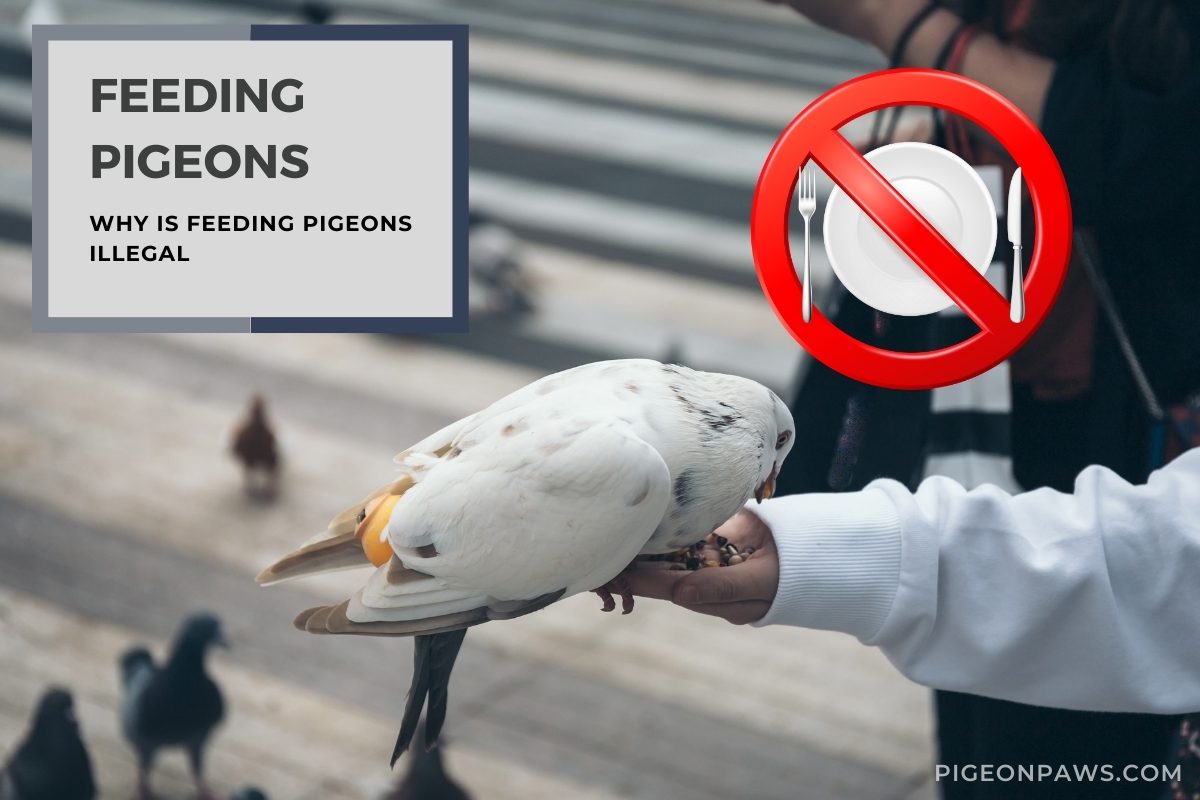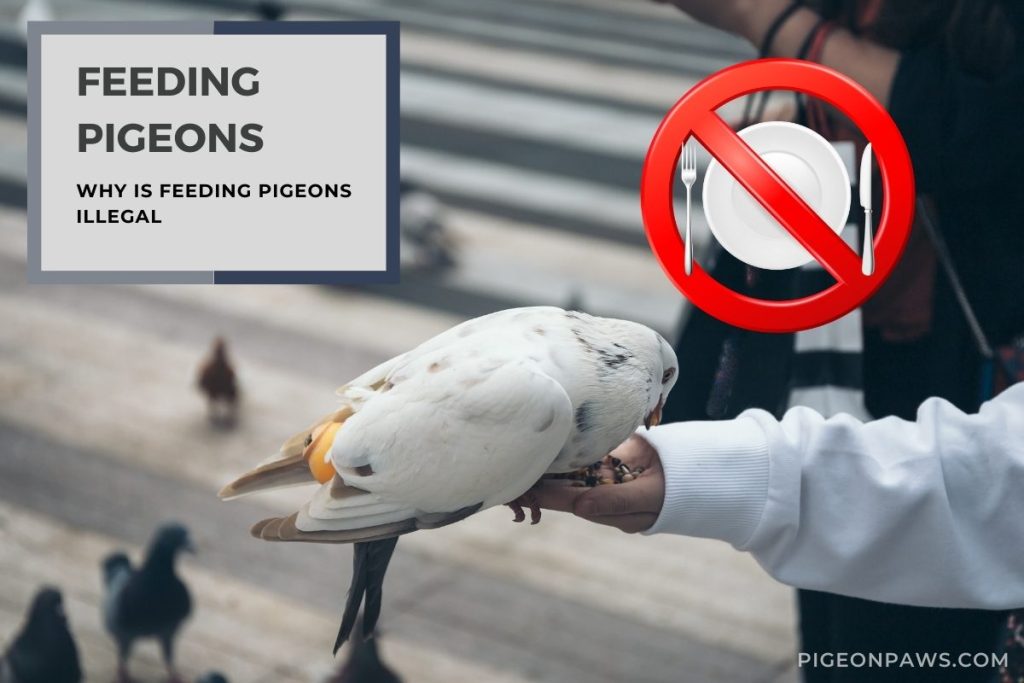Feeding Pigeons: Why Is Feeding Pigeons Illegal?

Walking in a park, enjoying the fresh air and nature’s beauty, you suddenly see a flock of pigeons flying toward you. They seem friendly and harmless, so you take out a packet of breadcrumbs from your bag and start feeding them.
While feeding pigeons in a park might seem like a harmless activity, it is, in fact, illegal in many places. The fines for feeding pigeons can be as high as $500. Feeding pigeons has become a growing concern in many urban areas as it contributes to an increase in their population and poses health risks to both pigeons and humans.
In this article, I’ll explain why feeding pigeons is banned in many regions and the consequences for the environment and public health. So, let’s get started and learn more!

What are the reasons behind the illegal feeding of pigeons?
Feeding these birds has become a contentious issue in many cities; in some places, it is even illegal. The reasons behind these laws are multifaceted and complex.
Health risks to humans
Pigeons carry a range of diseases and parasites, including Salmonella, E. coli, Cryptococcosis, and Histoplasmosis. These can be transmitted to humans through droppings, feathers, or direct contact.
Histoplasmosis, in particular, is a severe respiratory disease caused by inhaling fungus spores in pigeon droppings. The elderly, children and those with weakened immune systems are particularly vulnerable.
Environmental Risk
Feeding pigeons can lead to overpopulation, which can have negative environmental consequences. As the population increases, pigeon droppings can accumulate, leading to unsanitary conditions and potential damage to buildings, monuments, and other structures.
Health risks to pigeons
The act of providing sustenance to pigeons carries inherent dangers that may adversely affect the birds themselves.
Excessive consumption of food has the potential to foster obesity, a condition associated with adverse health outcomes such as cardiovascular disease and impaired liver function.
Similarly, the provision of unsuitable comestibles may result in malnourishment, compromising their immune system and rendering them more vulnerable to affliction.
Behavioral changes in pigeons
Regular feeding can cause pigeons to become dependent on humans for food, which can result in behavioral changes. They may lose their natural instincts for scavenging and become aggressive toward people who do not feed them.
Public Nuisance
The feeding of pigeons can also lead to a public nuisance. They are known to flock to areas where food is abundant, leading to large numbers of birds in public spaces. This can create a mess, as well as a nuisance for people who are trying to use the area.
What laws exist regarding feeding pigeons?
Feeding pigeons may seem like a harmless activity, but it is actually prohibited in many places around the world due to various reasons. Now, I’m going to explore the laws that exist regarding feeding pigeons.
Local ordinances
Many cities and towns have laws in place that prohibit feeding pigeons. These ordinances are usually put in place to control the pigeon population and prevent health hazards. Violation of these ordinances can lead to fines or other penalties.
State laws
In the United States, some states have laws that regulate the feeding of pigeons. For instance, in New York City, feeding pigeons is illegal and can result in a fine of up to $1,000. In Texas, it is illegal to feed pigeons in public places, which can cause a nuisance.
International laws
In some countries, feeding pigeons is considered a criminal offense. In Venice, Italy, feeding pigeons can result in a fine of up to 700 euros. In Singapore, it is illegal to feed pigeons in public places, and violators can be fined up to $500.
What are the environmental impacts of feeding pigeons?
Feeding pigeons not only affect human health and safety but also has a significant impact on the environment. Here are some of the environmental impacts of feeding pigeons:
Habitat Destruction
Feeding pigeons causes an increase in their population, leading to overcrowding and habitat destruction. Pigeons tend to roost in large groups in the same area, which can cause damage to buildings, bridges, and other structures.
Attracting predators
Feeding pigeons can attract predators such as rats and other vermin, which can lead to an increase in their population. This can cause a ripple effect, leading to an imbalance in the ecosystem.
Bird-to-Bird Disease Transmission
The act of providing sustenance to pigeons in public spaces has the potential to facilitate avian-to-avian contagion, thereby increasing the likelihood of disease propagation.
Disrupting Ecosystems
The non-indigenous presence of pigeons in specific ecosystems has the potential to significantly alter the natural balance, posing a threat to the biodiversity of affected regions.
It is essential to be aware of the impact of feeding pigeons on the environment and take steps to prevent it. One way is to dispose of food waste not and adequately feed pigeons in public areas.
Risks of Pigeon Feeding
Is Eating Grit Beneficial for Pigeons?
Pigeons’ grit consumption is vital for their digestive health. Grit, small stones or pebbles, helps them break down hard food in their gizzard, aiding digestion. Without it, pigeons may suffer from poor nutrition and digestion issues. The importance of pigeons’ grit consumption cannot be overlooked as it plays a crucial role in maintaining their overall well-being.
Alternatives to Feeding Pigeons
Although pigeon feeding may appear to be a benign pastime, it can yield adverse effects on both avian wellness and the ecosystem. Fortunately, there exist multiple alternatives to pigeon feeding that can satiate your inclination to engage with feathered creatures without inducing harm.
Bird Watching
Observing birds in their natural habitat without causing any disturbance is an excellent means of appreciating their beauty and comprehending their behavior and migration patterns. Bird watching offers an opportunity to witness the avian kingdom in its unadulterated form and provides valuable insights into their lives.
Plant Native Flowers
Incorporating indigenous flowers and shrubs into your lawn or communal green space has the potential to furnish avian species with nourishing sustenance. This practice not only contributes to the well-being of our feathered friends but also has the ability to enhance the ecological balance of the surrounding environment.
Use Bird Feeders
The utilization of bird feeders brimming with carefully selected seeds and nuts can effectively lure a diverse spectrum of avian species to your premises. This practice presents an exceptional opportunity to observe the birds’ behaviors and habits while simultaneously furnishing them with a wholesome dietary supplement.
Volunteering
Participating in community service at a nearby wildlife rehabilitation center or avian sanctuary offers a unique chance to engage with avifauna while concurrently promoting conservation objectives.
Conclusion
Feeding pigeons may seem like a harmless and enjoyable activity, but it can lead to severe health and environmental problems. It is essential to understand the risks associated with feeding pigeons and follow the laws and regulations in your area.
Feeding alternatives such as bird feeders and water fountains can provide a safer and more controlled environment for birds to feed. Additionally, educating others on the adverse effects of feeding pigeons can help prevent the spread of disease and damage to the environment.

